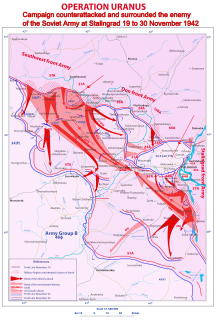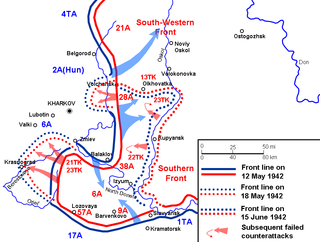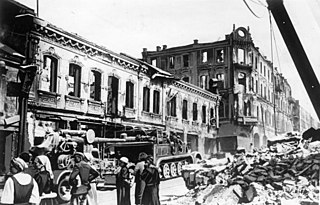
Operation Uranus was the codename of the Soviet Red Army 19–23 November 1942 strategic operation on the Eastern Front of World War II which led to the encirclement of the German Sixth Army, the Third and Fourth Romanian armies, and portions of the German Fourth Panzer Army. The operation was executed at roughly the midpoint of the five-month long Battle of Stalingrad, and was aimed at destroying German forces in and around Stalingrad. Planning for Operation Uranus had commenced in September 1942, and was developed simultaneously with plans to envelop and destroy German Army Group Center and German forces in the Caucasus. The Red Army took advantage of the German army's poor preparation for winter, and the fact that its forces in the southern Soviet Union were overstretched near Stalingrad, using weaker Romanian troops to guard their flanks; the offensives' starting points were established along the section of the front directly opposite Romanian forces. These Axis armies lacked heavy equipment to deal with Soviet armor.

The Second Battle of Kharkov or Operation Fredericus was an Axis counter-offensive in the region around Kharkov against the Red Army Izium bridgehead offensive conducted 12–28 May 1942, on the Eastern Front during World War II. Its objective was to eliminate the Izium bridgehead over Seversky Donets or the "Barvenkovo bulge" which was one of the Soviet offensive's staging areas. After a winter counter-offensive that drove German troops away from Moscow but depleted the Red Army's reserves, the Kharkov offensive was a new Soviet attempt to expand upon their strategic initiative, although it failed to secure a significant element of surprise.

The Battle of Białystok–Minsk was a German strategic operation conducted by the Wehrmacht's Army Group Centre under Field Marshal Fedor von Bock during the penetration of the Soviet border region in the opening stage of Operation Barbarossa, lasting from 22 June to 9 July 1941.

The Northwestern Front was a military formation of the Red Army during the Winter War and World War II. It was operational with the 7th and 13th Armies during the Winter War. It was re-created on 22 June 1941, the first day of the Soviet-German War on the basis of the Baltic Special Military District. On 22 June the Front consisted of the 8th, 11th, and 27th Armies, as well as the 5th Airborne Corps and the headquarters of the 65th Rifle Corps.
The 9th Army of the Soviet Union's Red Army was a Soviet field army, active from 1939–43.
The 270th Rifle Division was a Red Army infantry division formed twice during World War II, in 1941 and 1942.

The 8th Mechanized Corps, was a mechanized corps of the Soviet Ground Forces. It was destroyed in 1941 in the beginning of Operation Barbarossa.
The 37th Army was an Army-level formation of the Soviet Union during the Second World War. The army was formed twice during the war. The army was part of the Southern Group of Forces in Romania and Bulgaria.

The Battle of Rzhev in the Summer of 1942 was part of a series of battles that lasted 15 months in the center of the Eastern Front. It is known in Soviet history of World War II as the First Rzhev–Sychyovka Offensive Operation, which was defined as spanning from 30 July to 23 August 1942. However, it is widely documented that the fighting continued undiminished into September and did not finally cease until the beginning of October 1942. The Red Army suffered massive casualties for little gain during the fighting, giving the battle a notoriety reflected in its sobriquet: "The Rzhev Meat Grinder".
The 51st Rifle Division was an infantry division of the Soviet Army, formed twice. Its first formation was formed during the Russian Civil War and fought in the Perekop-Chongar Offensive in 1920. It also fought in the Soviet invasion of Poland, Winter War and World War II. During World War II, it fought in the Battle of Rostov, Barvinkove-Losowaja Operation and Second Battle of Kharkov before being destroyed at the Battle of Voronezh. Officially disbanded on 28 November 1942, the division was reformed on 15 April 1943 from the 15th Rifle Brigade. The 2nd formation fought in Operation Bagration and the Battle of Königsberg. It appears to have been disbanded in 1946.

The 81st Cavalry Division was a mounted division of the Red Army that served in the first years of the Great Patriotic War. It was formed in the autumn of 1941 and served in the region south of Stalingrad while the German Army besieged that city in the autumn of 1942. During the first stages of the Soviet counteroffensive, Operation Uranus, the 81st was given a prominent role in the exploitation to the southwest, but became overextended and vulnerable to the mobile German reinforcements arriving to attempt a breakthrough to their 6th Army. The division was badly mauled in the opening stages of Operation Winter Storm, but continued to serve in Southern Front's advance on Rostov and on into the Donbass. It was finally disbanded in May, 1943.
The 333rd Rifle Division began forming in the North Caucasus Military District in August, 1941, as a standard Red Army rifle division, as part of the massive mobilization of reserve forces very shortly after the German invasion. In 1942 it served in the late winter and early spring fighting near Kharkov, taking a beating both then and during the opening stages of the German summer offensive. Withdrawn into the reserves, the division was rebuilt in time to take part in the Soviet counteroffensive at Stalingrad in November, and played an important role in driving the German forces out of the Caucasus region during the winter. In the autumn of 1943 the division shared credit with the 25th Guards Rifle Division for the liberation of Sinelnikovo in the Dnipropetrovsk Oblast, receiving that place name as an honorific. After battling through Ukraine and into the Balkan states, the 333rd completed its combat path on a relatively quiet note doing garrison duties in the Balkans.
The 335th Rifle Division was first formed in September 1941, as a standard Red Army rifle division, at Stalingrad. It was a "sister" unit to the 341st Rifle Division, which was formed at about the same time and place and shared a very similar combat path in its first formation. The division was assigned to the southern sector of the Soviet-German front during the winter counteroffensive, but took severe losses during the German spring offensive that formed the Izium Pocket, and it was all but destroyed in the opening phase of Case Blue. The division was formed again nearly two years later, this time in the Far Eastern Front, and spent the rest of the war mainly on coastal defense duties. The 335th had one of the shortest and least distinguished careers of any Soviet rifle division.
The 275th Rifle Division was an infantry division of the Soviet Union's Red Army during World War II, formed twice.
The 411th Rifle Division was formed in September 1941 as an infantry division of the Red Army, at Chuhuiv in eastern Ukraine. It was a "sister" unit to the 393rd Rifle Division, which was formed at about the same time and place and shared a very similar combat path during 1941-42. The division was assigned to the southern sector of the Soviet-German front during the winter counteroffensive, but was encircled during the German spring offensive that formed the Izium Pocket; unable to escape as a formed unit, the scattered survivors were not sufficient to warrant rebuilding the division, and it was officially disbanded on June 30, 1942. The 411th had one of the shortest and least distinguished careers of any Soviet rifle division.
The 349th Rifle Division formed in September, 1941, as a standard Red Army rifle division, at Astrakhan. It was assigned to the southern sector of the Soviet-German front, and first saw action in January, 1942, during the winter counteroffensive, but was badly damaged during the German spring offensive that formed the Izium Pocket. The remaining men and equipment of the unit managed to retreat into the Caucasus region in the face of the German summer offensive in such a weakened state that German intelligence wrote the division off as destroyed in October. In fact, the cadre of the division survived, and was transferred to the reserves of Transcaucasus Front in that same month, where it slowly replenished as a low-priority unit. By the end of the year the 349th was assigned to 45th Army along the border with Turkey, and it remained on this quiet front for the duration of the war.

Vasily Minayevich Shugayev was a Soviet Army major general and a Hero of the Soviet Union.
The 393rd Rifle Division was raised in 1941 as an infantry division of the Red Army, and served twice during the Great Patriotic War in that role. In its first formation the division followed a very similar combat path to that of the 411th Rifle Division. It was first formed on October 1 in the Kharkov Military District, probably on the basis of militia units that had been raised there. It fought in the Barvenkovo–Lozovaya Offensive that created the Izium - Barvenkovo salient in January, 1942 and was intended to play a leading role in a spring offensive aimed at the liberation of Kharkov. In the event a German counteroffensive cut off the salient; the division was deeply encircled and destroyed. In the buildup to the Soviet invasion of Manchuria a new 393rd was formed in the Far Eastern Front in late 1944. The new division fought into the northern part of the Korean peninsula, taking many ports and cities with enough distinction that it was awarded the Order of the Red Banner, and continued to serve briefly into the postwar period.
The 14th Guards Rifle Division was reformed as an elite infantry division of the Red Army in January, 1942, based on the 1st formation of the 96th Rifle Division, which was officially a mountain unit at the time, and served in that role until after the end of the Great Patriotic War. It was in Southern Front when it was redesignated and was soon assigned to the 57th Army. It was encircled during the German counterattack in the Second Battle of Kharkov in May and its first commander was made a prisoner of war, later dying in German captivity. A cadre of the division managed to escape and was sent to the Reserve of the Supreme High Command for rebuilding. In July it joined the 63rd Army and took part in the attacks against the Italian 8th Army that created the bridgehead south of the Don River near Serafimovich during August. In October, now in 21st Army of Don Front, it was active in two probing attacks against the Romanian forces now containing the bridgehead which inflicted severe casualties in advance of the Soviet winter counteroffensive. At the start of that offensive the division was in 5th Tank Army, but was soon transferred to 1st Guards Army and then to the 3rd Guards Army when that was formed. It was under this Army as it advanced into the Donbass in late winter before returning to 57th Army during most of 1943, fighting through east Ukraine and across the lower Dniepr by the end of the year. After being briefly assigned to 53rd Army in December it was moved to 5th Guards Army in February, 1944 where it remained for the duration, mostly in the 33rd Guards Rifle Corps. It saw action in the Uman–Botoșani Offensive and won its first decoration, the Order of the Red Banner, as it advanced, before being involved in the frustrating battles along the Dniestr River on the Romanian border. In late spring, 1944 the division was redeployed north becoming part of 1st Ukrainian Front and taking part in the Lvov–Sandomierz Offensive into Poland. The 14th Guards made a spectacular advance across Poland during the Vistula-Oder Offensive and was awarded the Order of Lenin for its part in the liberation of Sandomierz. On January 22, 1945 its commander suffered mortal wounds in the fighting for a bridgehead over the Oder River. In the drive on Berlin in April the division and its regiments won further honors and decorations but despite these distinctions it was disbanded in August, 1946.

Feofan Agapovich Parkhomenko was a Soviet Army lieutenant general.









